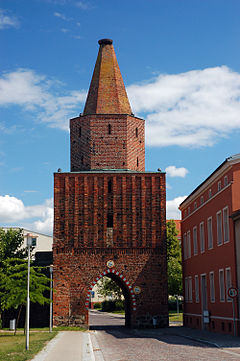| Capitulation of Pasewalk | |||||||
|---|---|---|---|---|---|---|---|
| Part of the War of the Fourth Coalition | |||||||
 The Pasewalk Mühlentor, an old city gate | |||||||
| |||||||
| Belligerents | |||||||
|
|
| ||||||
| Commanders and leaders | |||||||
|
|
| ||||||
| Strength | |||||||
| 700[1]–1,500 |
4,200[1] 8 guns | ||||||
| Casualties and losses | |||||||
| None |
4,200[1] soldiers captured, 8 guns captured, 37 colors captured | ||||||
The Capitulation of Pasewalk on 29 October 1806 resulted in the surrender of Oberst (Colonel) von Hagen's 4,200 Prussian soldiers to an inferior force of two French light cavalry brigades led by Generals of Brigade Édouard Jean Baptiste Milhaud and Antoine Lasalle. The Prussians were completely demoralized after a two-week-long retreat following their decisive defeat at the Battle of Jena-Auerstedt. Pasewalk is 110 kilometers north of Berlin and about 40 kilometers west of Szczecin (Stettin), Poland.
While retreating east toward Stettin on the Oder River, Hagen found his column trapped between Lasalle's brigade and Milhaud's brigade. Without attempting to break out, the baffled Prussian officer surrendered. The incident at Pasewalk came after a similar Prussian surrender after the Battle of Prenzlau the previous day. Within a week two fortresses would capitulate without firing a shot and a number of other Prussian columns would be hunted down one by one.
